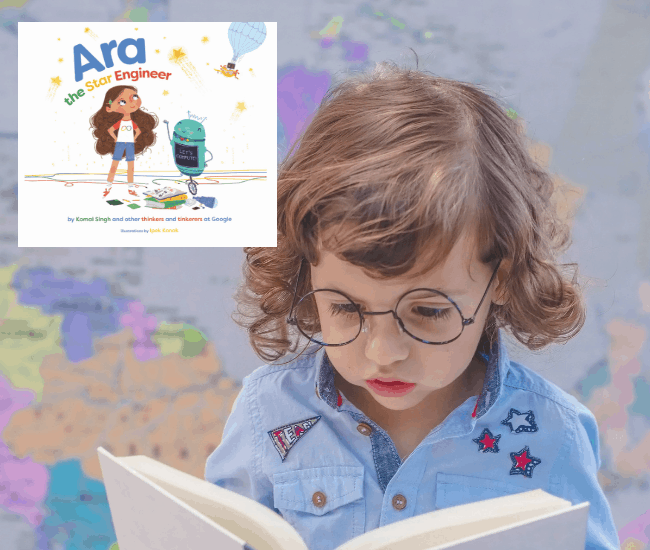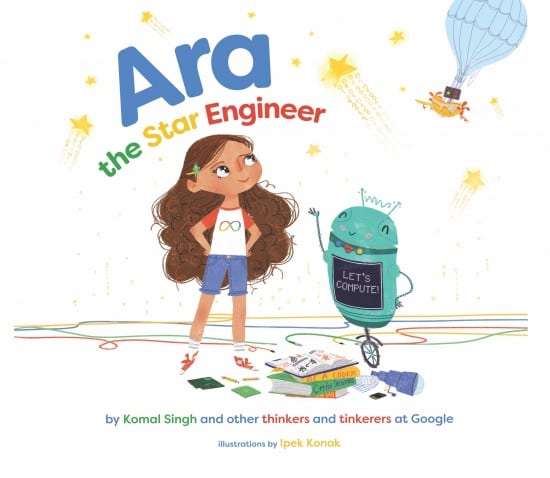Ara the Star Engineer by Komal Singh
What's It About?
“Engineers are boys!”That’s all Komal Singh needed. When the Google software engineer heard this cry from her 4-1/2-year-old daughter, it provided the springboard for Ara the Star Engineer (Page Two Books), a first-of-its-kind picture book designed to inspire girls and children of color to explore STEM (job fields of science, technology, engineering, and math.)
The troubling lack of women and people of color in STEM is big problem, and it begins in childhood:
- Girls start doubting their STEM intelligence by age six.
- Women make up only 25 percent of the STEM workforce.
- Black men and black women only make up to 3 percent and 2 percent of scientists, respectively.
So Singh and fellow female Google engineers decided to volunteer their spare time to do something about it and write Ara the Star Engineer.
Komal Singh and I have much in common – her mission is mine as well, and the inspiration behind my Edge of Yesterday book series. I was fortunate to have the chance recently to interview her about her new book.
![]()
Robin Stevens Payes: I loved the idea that Ara provides a way for children to identify and gain a glimpse inside the world of technology and work through a story. What inspired you to write this book for young audiences?
Komal Singh: I was struggling to find a bedtime book for my 4-1/2-year-old daughter that had that right mix of storytelling and whimsy, but also introduced her—and children in general—to some technical aspects of computer science or engineering, all in a whimsical manner.
In the end, it was something my daughter said to me, that engineers are boys. I was working from home, on a work call. And she could see all the faces and lists of people who were on the call. And she asked me, tell me Mama, who’s that, and what does he do. So I said, yes, that’s Mike, he’s an engineer. That’s Alex, he’s an engineer. It was a list of 10 people, my co-workers, all male. So she said, “Oh, then all engineers are boys.”
That really bummed me out. So I researched more to see when children start developing unconscious and implicit biases. And there’s research out there that says it starts when kids are six years old.
RSP: Wow, it starts that young!
KS: It’s pretty shocking. Knowing that, I wanted to make sure there were some good role models out there, to help girls and boys understand that engineers are girls and boys, and people of color. It’s important to portray that diversity.
As far as books go, especially picture books, less than five percent feature people of color in a lead capacity, or are authored by people of color.
So I very deliberately wanted to do something for the pre-K bracket. I think storybooks are such a universal medium for young children, and something all parents enjoy doing with their kids, reading books. And we feature some real-life trailblazers who are into computing, to help young children set their sights on something that’s a place for girls to succeed as well as boys.
RSP: The storytelling is near and dear to my heart as well. What do you hope will be the outcome in this effort?
KS: As a long-term goal, I hope the readers are converted into future leaders in technology. Short and intermediate term, I think I just want kids to have fun with words like algorithm and brainstorming and troubleshooting. And get comfortable using these words in their everyday vocabularies.
I hear some parents [who’ve read the book to their kids] saying, “Oh, my daughter has been wanting to write an algorithm, and my son wants to troubleshoot everything in the house since he’s read the book. Or things like, going to bed: they are breaking the problem into small steps, and that’s really what troubleshooting is. If we get kids to think in that manner, we are teaching them to be good problem solvers, even if they don’t go into technology.
I want the book to help them become problem solvers, and see that it’s okay for women to be leaders (or sheroes, as we call them). It’s completely fine for women to lead, or for men and women to have women leaders around them.
RSP: Give us an overview of the story to give our readers a taste.
KS: The story is about a young girl, Ara, who’s around six years old, and she loves big problems and big numbers. Today, she wants to count all the stars in the sky, but she’s not sure how that can be done. So, along with her robot assistant, DeeDee, Ara decides to visit this fantastical land, Innovation Plex. And here they meet a very diverse set of superheroes, or “sheroes,” who teach them about engineering and problem solving, and how to think about counting all the stars in the sky.
In the end, with the help of the sheroes, they’re able to count all the stars, they’re able to solve this problem, but they also discover an amazing algorithm for success, which is comprised of courage, creativity, coding and collaboration.
RSP: I love that you bring in those qualities of character as well.
KS: Yes, you know, coding is great, but in order to work with people, you have to be more than just a coder. You have to know how to collaborate with your peers. You have to have the courage to take on a big challenge: I’m going to build a good team, and we’re going to solve a problem. You have to be creative with your ideas, to do something that’s not been done before.
RSP: I assume you’ve read the story to your kids. What’s their reaction been?
KS: Yes, I have. My boy is only 10 months, so he’s seen the pictures and heard the words, but we don’t yet know what he understands. My daughter thinks it’s some sort of an arts-and-crafts project that I built for her, which she really loves. And she told me, “Oh, Mama, I love this book, and googolplex. But I only love quadrillions, so I think you’ll need to make up a different story.”
RSP: Did you involve her ideas at all in writing your book?
KS: I did. She’s the one who loves big numbers. She knows what infinity is, what a googolplex is, what a quadrillion is. So the idea of big numbers came from her imagination and how she goes about comparing numbers in her own head. She would be like, oh this pool of water is smaller than all the sky. The way she relates things all around her to big numbers. That’s where the premise came from for the plot of the book.
RSP: Now that you’re an author and an engineer, what do you see unfolding for you next?
KS: I wish I could time travel so that I knew! I’m hoping that I can continue both parts: being a full-time engineer and being an author on the side as my passion project. I would love to write more books, to explain to kids what artificial intelligence is, what terabytes and gigabytes means. There’s lots to write about.
RSP: Now that you have this platform where you combine engineering, writing, math, computer science and project management – all these great and very important emerging skills, I think you have a unique opportunity to really help shine a light for young children.
KS: I would want to use this platform very wisely and productively, to do things for the right reasons.
In addition to writing the picture book, Ara the Star Engineer, Komal Singh has created a virtual reality app, Ara the Star, as part of Google Expeditions, available in the App Store in your favorite format.
Ara the Star Engineer is now available for purchase.
Buy this Book!
Amazon





